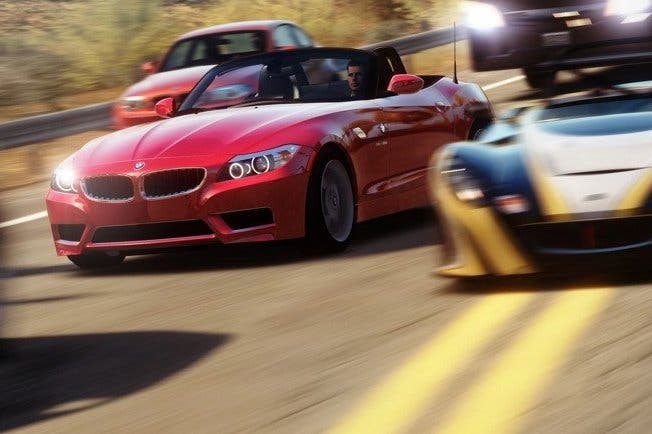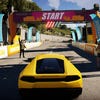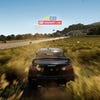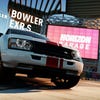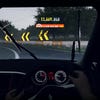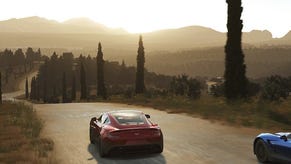Digital Foundry: Hands-on with the Forza Horizon 2 demo
Driving excitement.
As platform comparisons go, Forza Horizon 2 vs DriveClub promises to be one of the most exciting console clashes of this year's holiday season. There's certainly much in common between the two titles, with each boasting similarly advanced rendering features, tight online integration, and native 1080p visuals operating at a locked 30fps. But where Playground Games' Xbox sequel hopes to differentiate itself is in its focus on delivering a rich and unrestrained open world where players are free to explore and tackle challenges as they see fit. How well that would actually work wasn't clear until the release of the Forza Horizon 2 demo earlier this week - our first chance to get uninterrupted hands-on time with the game.
First impressions are positive. Set across South of France and parts of Northern Italy, our first glimpses of the world in Forza Horizon 2 are filled with large, intricate landscapes spanning rolling hillsides, rocky cliff faces, and stretches of countryside filled with winding roads and fields rich with foliage and farming crops. This is nicely demonstrated in the demo as we first make our way around cliff-side coastal roads in a yellow Lamborghini before heading inland across the countryside to our eventual destination, the Horizon festival.
Draw distances are impressive with buildings, trees, and plants visible far into the horizon. While there are restrictions on how far you can drive in the demo, generally speaking if you can see an area, you can reach it, cutting across fields and driving up hillsides to get there. LOD (level of detail) transitions are for the most part kept in check too, although we find that higher quality assets for foliage pop in quite late, which is quite noticeable when tearing through the scenery at over 100mph, while shadows frequently flicker as you approach them. Textures mostly appear pretty crisp and clear, although the low level of anisotropic filtering is disappointing - details on the ground start to blur from just a few metres away.
Despite a few graphical niggles, Forza Horizon 2 is an impressive sight, and the level of detail still stands out when exploring the lavish landscape Playground Games has created: foliage and crops densely litter field and farm lands, bumps and cobblestones are spread across old roads, while buildings, trees, and other objects that span the environment can be seen for miles around.
The use of advanced physically-based rendering of materials helps to bring out a striking look to cars and the environments. All surfaces in the game accurately react to the surrounding lighting conditions, while light sources are rendered in real time, from the headlights on the cars to the soft glow of street lamps at night. At times some of the environments appear almost photo-realistic, but this sense of authenticity is partially compromised by the slightly over-saturated presentation, featuring some bold colours, heavy use of bloom and lens flare, and cars that appear just a touch too artificially shiny under the full glimmer of the sun. Sometimes, the bright daytime lighting also give cars a cut-out look against the scenery in certain conditions, which can appear a little odd.
These lighting decisions seem like a stylistic choice designed to give Forza Horizon a distinctive look that sits in between the pastel vibrancy of arcade racers and muted tones of driving games aiming for absolute realism. It's a look that gives the game a slightly casual feel without completely losing the authenticity you'd expect to find in more serious racing games, although not without creating a slightly surreal appearance in common with a stylised car commercial.
This balancing act is also clearly felt in the handling model of the cars which blend together a realistic feel to racing around at high speed with an ample degree of accessibility for new players and fans of arcade driving games to enjoy. There's an air of simulation running through how the cars are affected by changes in weight shift and suspension when turning corners or riding over bumpy terrain, but at the same time control is easy to get to grips with using the default settings and allows for plenty of flashy driving without requiring the skills of a professional racer. Turning off various assists - such as ABS, traction control and stability control - returns a distinct danger to the way the cars handle across different surfaces and when carelessly oversteering into corners at speed, with the simulation model moving closer into line with the core Forza experience at that point.
The handling model is also affected by the surface of the road under different weather conditions, with cars behaving a little more loosely on drenched roads compared to those that are just a little wet. The blustery and wet conditions in the second race included in the demo also demonstrate the attention to detail in how rain and water are rendered on screen: simulated raindrops crawl across the bodywork and windscreen of the cars, while the puddles of water slowly fill up the cracks and dips in the road, before evaporating as the rain subsides once the race is over and the sun's rays once again beam onto the environment.
Further inspection of the demo shows that Forza Horizon 2 delivers its visual punch with a crisp native 1080p resolution, as promised by the developers earlier in the year. The anti-aliasing solution is also given a boost over that of Forza 5 via the use of 4x MSAA (multi-sampling anti-aliasing) - a bandwidth-heavy choice that we rarely see in use on console. Coverage is decent, with less shimmering on distant objects compared to Forza 5. On the other hand, there's a big difference in frame-rate between these two games: Forza 5 delivers a silky-smooth 60fps presentation, while Forza Horizon 2 cut this in half down to 30fps.
This drop in frame-rate can certainly be felt in the handling - cars have an additional weightiness to them - but the controls still feel highly responsive for a 30fps title. The decision to target a 30fps update is something of a controversial decision for devotees of Turn 10's series, but according to Forza Horizon 2 developer, Playground Games, this was required in order to achieve smooth gameplay at a steady rate while rendering a large, open-world environments.
"I think what we did on Horizon was demonstrate that, and this is really important, a locked frame rate that's absolutely solid and never drops is the most important thing for our game," Playground's Ralph Fulton told IGN. "30 [frames per second] actually enables us to realise that experience."
Impressively, despite the demanding open-world set-up and an avalanche of advanced rendering effects, Forza Horizon 2 holds a solid 30fps throughout the demo without ever dropping a single frame during gameplay, no matter how carelessly we ploughed through the scenery and collided with other vehicles - driving feels smooth and responsive in a variety of weather and road conditions.
The only tangible distractions come from the shakiness of the camera when you drive across country fields as your car's suspension attempts to counteract the resulting turbulence. The judder here is intentional of course, adding a considerable amount of intensity to off-road racing at high speed - it's part and parcel of having an authentic racing experience where the environment actually impacts upon your driving.
In the limited demo environment we've only seen a snapshot of what Forza Horizon 2 has to offer, but our first impressions are highly positive. While it's hard to make judgements on the full scope of the game from just a brief hands-on, what's been shown so far certainly exceeds the original Forza Horizon in all areas, while substantially ramping up the level of detail and effects work in line with what is expected from a current/next-gen release.
Of course, Forza Horzon 2 is launching across two different platforms in just over a week, with the 360 getting a version of the game built on the engine that powered the original Forza Horizon. Much of the visual impact in this sequel on the Xbox One is down to the advanced rendering features only possible on the new consoles, so it will be interesting to see how much of the core feel and atmosphere is retained when these are missing. However, the 360 version seems to be in good hands with Sumo Digital at the helm, so hopefully the core gameplay experience itself shouldn't be too different.
